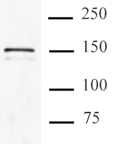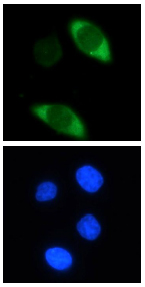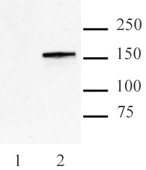Cas9 antibody (mAb) (Clone 7A9-3A3)
Host / Isotype
Mouse / IgG1k
Reactivity
Human, Not Species Specific
Applications
ChIP, ICC, IF, IP, WB
CloneNo.
7A9-3A3
Cat No : 61577,61578,61978 61577
Synonyms
Validation Data Gallery
Product Information
| Tested Applications |
ChIP, ICC, IF, IP, WB
Applications Validated by Active Motif: IP: 5 ug per IP ICC/IF: 0.5 - 2 ug/ml dilution WB: 0.1 - 1 ug/ml dilution |
| Tested Reactivity | Human, Not Species Specific |
| Host / Isotype | Mouse / IgG1k |
| Class | Monoclonal |
| Type | Antibody |
| Immunogen | This antibody was raised against a recombinant protein within the N-terminal region of Streptococcus pyogene Cas9. This antibody should recognize Cas9 and dCas9 based on the antigen design. |
| Full Name | Cas9 antibody (mAb) (Clone 7A9-3A3) |
| Synonyms | Cas9, Streptococcus pyogenes, CRISPR, clustered regularly interspaced short palindromic repeat, gene-editing, guide RNA, nuclease, endonuclease, targeting, DNA, double-strand break, RNA, genome editing, wb, ip, if, western blotting, immunoprecipitation, immunoflourescence, antibody, antibodies, mab, monoclonal, sample |
| Molecular weight | 160 kDa |
| GenBank accession number | WP_014407541 |
| RRID | AB_2793684 |
| Purification Method | Protein G Chromatography |
| Buffer | Purified IgG in PBS with 30% glycerol and 0.035% sodium azide. Sodium azide is highly toxic. |
| Storage | Some products may be shipped at room temperature. This will not affect their stability or performance. Avoid repeated freeze/thaw cycles by aliquoting items into single-use fractions for storage at -20°C for up to 2 years. Keep all reagents on ice when not in storage. |
Background Information
Cas9 is a nuclease from Streptococcus pyogenes that can be targeted to particular DNA sequences through a guide RNA that results in double-stranded breaks in DNA. Cas9 is part of the CRISPR/Cas9 gene-editing system that can create a DNA break at a specific location with the genome. CRISPR (clustered regularly interspaced short palindromic repeat) is an adaptive immune system that provides protection against mobile genetic elements (viruses, transposable elements and conjugative plasmids). CRISPR clusters contain spacers, sequences complementary to antecedent mobile elements, and target invading nucleic acids. CRISPR clusters are transcribed and processed into CRISPR RNA (crRNA) Probable. In type II CRISPR systems correct processing of pre-crRNA requires a trans-encoded small RNA (tracrRNA), endogenous ribonuclease 3 (rnc) and this protein. The tracrRNA serves as a guide for ribonuclease 3-aided processing of pre-crRNA. Subsequently Cas9/crRNA/tracrRNA endonucleolytically cleaves linear or circular dsDNA target complementary to the spacer. The target strand not complementary to crRNA is first cut endonucleolytically, then trimmed by 3'-5' exonucleolytically. DNA-binding requires protein and both RNA species. Cas9 probably recognizes a short motif in the CRISPR repeat sequences (the PAM or protospacer adjacent motif) to help distinguish self versus nonself.



